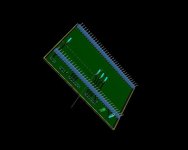liveforphysics
100 TW
Could be closed loop. Float the advance at the current draw minima for a given motor rpm, then make the 95%-100% area run a torque maximizing advance.
lifepo4ever said:i tougth the 120% trottle was a timing advance i hope this little device board is better to save some current and ready to buy one when the bolt on version is available
i still don't understand nothing but i enjoy the post :lol: :lol: :lol: :lol:
fechter said:I think the optimum advance will be a function of both RPM and motor load (current). At light load you can use more advance. If you took signals for the RPM and current, you might be able to come up with a formula that will calculate the advance. It would still take some dyno testing to find the sweet spots.
I wonder if there may be some other measurable thing that would indicate optimum timing?
Burtie said:lifepo4ever said:i tougth the 120% trottle was a timing advance i hope this little device board is better to save some current and ready to buy one when the bolt on version is available
i still don't understand nothing but i enjoy the post :lol: :lol: :lol: :lol:
I dont believe the infineon controller is capable of applying timing advance. I think the 120% speed setting just scales the throttle signal and removes any small amount of PWM that may be present at WOT. And this accounts for the extra speed that some people have noticed (especially if their throttle output voltage does not quite get high enough).
I am sure Jeremy checked this out in a previous thread somewhere, I will edit in a link to it if I can find it.

parabellum said:Excellent work Burtie! I would like to buy 1 when you have them in sale.
Do I understand well? If motor with fixed halls and running it on 36V system will need X degree advance, same motor running with same controller on 72V will need 2X degree advance? Is efficiency of advancing option, rpm dependent? Linear to rpm?
+1... If it comes with an instruction manual, video, ES thread, well something, so I can know how to use it & what it can do.etard said:Truly awesome product, My vote for Burtie as "Mad Scientist of the Year!" So it will also work to optimize hall placement positioning, or rather hall sensors that aren't positioned optimally. WOW! This gives everyone who doesn't have a scope the ability to tune hall sensors without moving them? Will you lose some timing ability if this is the case? Put me on the list for one Burtie, these things should be snatched up like hotcakes when they become available.
If I am reading it correctly it will work with anything with hall sensors!lifepo4ever said:i hope they can make something for 9c hub motor one day also


Arlo1 said:Awesome. But I have a Hunch load will effect the perfect timing by quite a bit as well! I think of it this way with only 5 amps flowing in the stator as a unloaded current then there is a lot of pwm and it needs a lot of time to energise the stator with the low current, where as with a load it will energise faster because of the smaller amount of pwm. Amonst other things like the fact the once loaded it cant rev up as fast as well.
I am also very excited for this and cant wait to see how it all unfolds.
